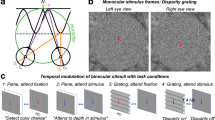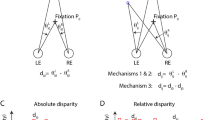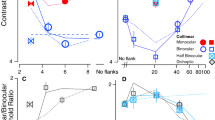Abstract
EARLY visual processing is organized into a number of independent channels. In the retina, increments and decrements of brightness are processed independently by different groups of neurons1. For psychophysical measurements of human vision, independence can be tested statistically. Using this criterion in a depth judgement task, we show here that, for binocular stereo vision, increments and decrements are treated independently, at least as far as the level at which information from the left and right eyes is first combined. At later stages of stereo processing, the information from the two channels is no longer independent. Because the signals for stereo vision are first combined at the visual cortex, these results suggest that the neural 'on' and 'off channels remain independent right up to early cortical stages. Theoretical studies of stereo vision have proposed that visual features in the views of the two eyes are matched on the basis of 'similarity'2. Our results show that stereo matching treats features as statistically independent (and therefore dissimilar) if they appear perceptually bright and dark relative to the background. If features differ perceptually but only in the degree of brightness or darkness, human stereo vision treats them as similar.
This is a preview of subscription content, access via your institution
Access options
Subscribe to this journal
Receive 51 print issues and online access
$199.00 per year
only $3.90 per issue
Buy this article
- Purchase on Springer Link
- Instant access to full article PDF
Prices may be subject to local taxes which are calculated during checkout
Similar content being viewed by others
References
Schiller, P. H. Trends Neurosci. 15, 86–92 (1992).
Marr, D. & Poggio, T. Proc. R. Soc. B204, 301–328 (1979).
Schiller, P. H., Sandell, J. L. & Maunsell, J. H. R. Nature 322, 824–825 (1986).
Dolan, R. P. & Schiller, P. H. Visual Neurosci. 11, 23–32 (1994).
McConnell, S. K. & LeVay, S. Proc. natn. Acad. Sci. U.S.A. 81, 1590–1593 (1984).
Zahs, K. R. & Stryker, M. P. J. Neurophysiol. 59, 1410–1429 (1988).
DeValois, K. K. Vision Res. 17, 209–215 (1977).
Burton, G. J., Nagshineh, S. & Ruddock, K. H. Biol. Cyber. 27, 189–197 (1977).
Bjorklund, R. A. & Magnussen, S. Perception 10, 511–518 (1981).
Hanly, M. & MacKay, D. M. Expl Brain Res. 35, 37–46 (1979).
Julesz, B. Foundations of Cyclopean Perception (Univ. Chicago Press, Chicago, 1971).
Barlow, H. B. Vision Res. 18, 637–650 (1978).
Harris, J. M. & Parker, A. J. J. opt. Soc. Am. A1, 14–24 (1992).
Harris, J. M. & Parker, A. J. Vision Res. 34, 2761–2772 (1994).
Burgess, A. & Barlow, H. B. Vision Res. 23, 811–820 (1983).
Barlow, H. B. & Reeves, B. C. Vision Res. 19, 783–793 (1979).
Pollard, S. B., Mayhew, J. E. W. & Frisby, J. P. Perception 14, 449–470 (1985).
Marr, D. & Poggio, T. Science 194, 283–287 (1976).
Baker, H. H. & Binford, T. O. Proc. 7th Int. Joint Conf. Artificial Intelligence 631–636 (1981).
von Helmholtz, H. Handbook of Physiological Optics 3rd edn (1910, translated 1925 by Southall, J.) (Dover Publications, New York, 1953).
Kaufman, L. & Pitblado, C. B. Percept. Psychophys. 6, 10–12 (1969).
Watt, R. J. & Morgan, M. J. Vision Res. 25, 1661–1674 (1985).
Levi, D. M. & Westheimer, G. J. opt. Soc. Am. A4, 1304–1313 (1987).
Levi, D. M., Jiang, B.-C. & Klein, S. A. Vision Res. 30, 1735–1750 (1990).
Edwards, M. & Badcock, D. R. Vision Res. 34, 2849–2858 (1994).
Morgan, M. J. & Glennerster, A. Vision Res. 31, 2075–2083 (1991).
Author information
Authors and Affiliations
Rights and permissions
About this article
Cite this article
Harris, J., Parker, A. Independent neural mechanisms for bright and dark information in binocular stereopsis. Nature 374, 808–811 (1995). https://doi.org/10.1038/374808a0
Received:
Accepted:
Issue Date:
DOI: https://doi.org/10.1038/374808a0
This article is cited by
-
Flies and humans share a motion estimation strategy that exploits natural scene statistics
Nature Neuroscience (2014)
-
Binocular correspondence in stereoscopic vision
Eye (1996)
Comments
By submitting a comment you agree to abide by our Terms and Community Guidelines. If you find something abusive or that does not comply with our terms or guidelines please flag it as inappropriate.



